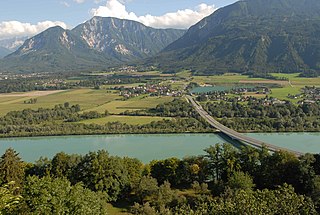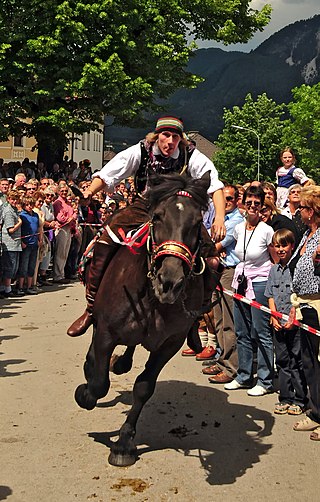
Klagenfurt am Wörthersee is the capital and largest city of the Austrian state of Carinthia, as well as of the historical region of Carinthia including Slovene Carinthia. With a population of 104,862, it is the sixth-largest city in Austria after Vienna, Graz, Linz, Salzburg, and Innsbruck. The city is the bishop's seat of the Roman Catholic Diocese of Gurk-Klagenfurt and home to the University of Klagenfurt, the Carinthian University of Applied Sciences and the Gustav Mahler Private University for Music. Klagenfurt is considered the cultural centre of the Carinthian Slovenes, one of Austria's indigenous minorities.

Villach is the seventh-largest city in Austria and the second-largest in the federal state of Carinthia. It is an important traffic junction for southern Austria and the whole Alpe-Adria region. As of January 2018, the population is 61,887.

Carinthia is the southernmost and least densely populated Austrian state, in the Eastern Alps, and is noted for its mountains and lakes. The main language is German. Its regional dialects belong to the Southern Bavarian group. Carinthian Slovene dialects, forms of a South Slavic language that predominated in the southeastern part of the region up to the first half of the 20th century, are now spoken by a small minority in the area.

Bleiburg is a small town in the south Austrian state of Carinthia (Koroška), south-east of Klagenfurt, in the district of Völkermarkt, some four kilometres from the border with Slovenia.

Erik Schinegger is an Austrian intersex skier. He was the women's downhill ski world champion in 1966, at which time he was recognized as female and known as Erika Schinegger.
Bezirk Villach-Land is a district of the state of Carinthia in Austria.

Hermagor-Pressegger See is a town in the Austrian state of Carinthia. It is the administrative centre of the Hermagor District. The town is named after Saint Hermagoras of Aquileia, the first bishop of Aquileia.

Arriach is a municipality in the district of Villach-Land in the Austrian state of Carinthia.

Ferndorf is a municipality in the district of Villach-Land in the Austrian state of Carinthia.

Finkenstein am Faaker See is a market town in the district of Villach-Land in Carinthia, Austria.

Nötsch im Gailtal is a market town in the district of Villach-Land in the Austrian state of Carinthia.

Paternion is a market town in the district of Villach-Land in the Austrian state of Carinthia. It is located within the Drava valley about 18 kilometres (11 mi) in the north-west of the city of Villach.
The 1348 Friuli earthquake, centered in the South Alpine region of Friuli, was felt across Europe on 25 January. The earthquake hit in the same year that the Great Plague ravaged Italy. According to contemporary sources, it caused considerable damage to structures; churches and houses collapsed, villages were destroyed and foul odors emanated from the earth.

Wels Hauptbahnhof, occasionally Wels Central Station or Wels central station is a railway station at Wels, which is the second largest city in the federal state of Upper Austria, in the north of Austria.

The Carinthian Peasant Revolt took place in the Duchy of Carinthia in 1478. It was the first of several larger peasant revolts in the area of Inner Austria. After several Ottoman raids from 1473 onwards, the rural population established a peasants' association that was an effort to take the defence of the farmers' homes into their own hands and was also aimed against the ruling nobility that had failed to protect the farmers from attacks by marauding Turkish akinji cavalry. The revolt was eventually suppressed.

The Battle of Feistritz saw an Imperial French corps led by Paul Grenier attack an Austrian brigade under August von Vécsey. After putting up a stout resistance, the outnumbered Austrians were defeated and forced to retreat. The clash occurred during the War of the Sixth Coalition, part of the Napoleonic Wars. Feistritz im Rosental is located on the right bank of the Drava River near the southern border of Austria, about 16 kilometres (10 mi) southwest of Klagenfurt. At the time, it was located at the border with the French-controlled Illyrian Provinces to its west and south.

Villach Friary is a Franciscan friary, responsible for the parish of St. Nicholas in Villach, Carinthia, Austria.

Slovene quintain is a traditional Slovene mounted folk game, a form of jousting, that has been preserved in the southern Austrian state of Carinthia. It is held during Kirchweih festivals in the lower Gail Valley, where it has become a major tourist attraction. The štehvanje competition has also taken place every year in Savlje, Ljubljana and sometimes in neighboring villages since the 1930s.

The Carinthia S-Bahn is a regional transport system in the Austrian state of Carinthia and East Tyrol. The system is operated by the ÖBB, the national railway company.
The Rosen Valley Railway is a mainly Austrian railway that runs from Sankt Veit an der Glan via Klagenfurt and Rosenbach to Jesenice in Slovenia. The section between Rosenbach and Jesenice through the Karawanks Tunnel is part of and international long-distance route between Salzburg and Zagreb. The railway line is operated by the ÖBB. Traffic between Weizelsdorf and Rosenbach was suspended at the commencement 2016/17 timetable change. The line was sold to the state of Carinthia. NBIK heritage trains have been running between Weizelsdorf and Feistritz since the summer of 2020.





















